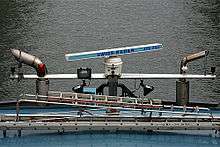Marine radar



Marine radars are X band or S band radars to provide bearing and distance of ships and land targets in vicinity from own ship (radar scanner) for collision avoidance and navigation at sea.
Radar is a vital component for safety at sea and near the shore. Captains need to be able to maneuver their ships within feet in the worst of conditions and to be able to navigate "blind". This means inside a dark room with no visibility they need to safely navigate their way through waters in the worst of weather. Radars are rarely used alone in a marine setting. In commercial ships, they are integrated into a full system of marine instruments including chartplotters, sonar, two-way radio communication devices, and emergency locators (SART).
The integration of these devices is very important as it becomes quite distracting to look at several different screens. Therefore, displays can often overlay charting, radar, sonar into a single system. This gives the captain unprecedented instrumentation to maneuver the ship. With digital backbones, these devices have advanced greatly in the last years. For example, the newer ones have 3D displays that allow you to see above, below and all around the ship, including overlays of satellite imaging.
In port or in harbour, shore-based vessel traffic service radar systems are used to monitor and regulate ship movements in busy waters.
Collision avoidance
As required by COLREGS, all ships shall maintain a proper radar lookout if it is available on board to obtain early warning of risk of collision. Radar plotting or the ARPA should be used to get the information of movement and the risk of collision (bearing, distance, CPA (closest point of approach), TCPA (time of closest point of approach) of other ships in vicinity.
Navigation
Marine radar systems can provide very useful radar navigation information for navigators onboard ships. The ship's position could be fixed by the bearing and distance information of a fixed, reliable target on the radar screen.
Radar controls
Marine radar has performance adjustment controls for brightness and contrast, gain, tuning, sea clutter and rain clutter suppression, and interference reduction. Other common controls consist of range scale, bearing cursor, fix/variable range marker or bearing/distance cursor.
See also
References
External links
- Calculatoredge.com
- Radartutorial.eu
- Earth.esa.int
- Alphalpha.org
- Macuait.com
- Radar in the 21st Century